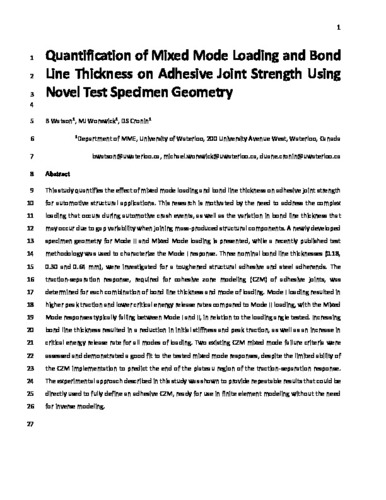| dc.contributor.author | Watson, Brock | |
| dc.contributor.author | Worswick, Michael J. | |
| dc.contributor.author | Cronin, Duane | |
| dc.date.accessioned | 2023-05-01 19:26:44 (GMT) | |
| dc.date.available | 2023-05-01 19:26:44 (GMT) | |
| dc.date.issued | 2020-10 | |
| dc.identifier.uri | https://doi.org/10.1016/j.ijadhadh.2020.102682 | |
| dc.identifier.uri | http://hdl.handle.net/10012/19384 | |
| dc.description | The final publication is available at Elsevier via https://doi.org/10.1016/j.ijadhadh.2020.102682. © 2020. This manuscript version is made available under the CC-BY-NC-ND 4.0 license http://creativecommons.org/licenses/by-nc-nd/4.0/ | en |
| dc.description.abstract | This study quantifies the effect of mixed mode loading and bond line thickness on adhesive joint strength or automotive structural applications. This research is motivated by the need to address the complex loading that occurs during automotive crash events, as well as the variation in bond line thickness that may occur due to gap variability when joining mass-produced structural components. A newly developed specimen geometry for Mode II and Mixed Mode loading is presented, while a recently published test methodology was used to characterize the Mode I response. Three nominal bond line thicknesses (0.18, 0.30 and 0.64 mm), were investigated for a toughened structural adhesive and steel adherends. The traction-separation response, required for cohesive zone modeling (CZM) of adhesive joints, was determined for each combination of bond line thickness and mode of loading. Mode I loading resulted in higher peak traction and lower critical energy release rates compared to Mode II loading, with the Mixed Mode responses typically falling between Mode I and II, in relation to the loading angle tested. Increasing bond line thickness resulted in a reduction in initial stiffness and peak traction, as well as an increase in critical energy release rate for all modes of loading. Two existing CZM mixed mode failure criteria were assessed and demonstrated a good fit to the tested mixed mode responses, despite the limited ability of the CZM implementation to predict the end of the plateau region of the traction-separation response. The experimental approach described in this study was shown to provide repeatable results that could be directly used to fully define an adhesive CZM, ready for use in finite element modeling without the need for inverse modeling. | en |
| dc.language.iso | en | en |
| dc.publisher | Elsevier | en |
| dc.relation.ispartofseries | International Journal of Adhesion and Adhesives;102682 | |
| dc.subject | mixed mode loading | en |
| dc.subject | adhesive joint strength | en |
| dc.subject | traction-separation response | en |
| dc.subject | bond line thickness | en |
| dc.subject | cohesive zone modeling | en |
| dc.title | Quantification of Mixed Mode Loading and Bond Line Thickness on Adhesive Joint Strength Using Novel Test Specimen Geometry | en |
| dc.type | Article | en |
| dcterms.bibliographicCitation | Watson, B., Worswick, M. J., & Cronin, D. S. (2020). Quantification of mixed mode loading and bond line thickness on adhesive joint strength using novel test specimen geometry. International Journal of Adhesion and Adhesives, 102, 102682. https://doi.org/10.1016/j.ijadhadh.2020.102682 | en |
| uws.contributor.affiliation1 | Faculty of Engineering | en |
| uws.contributor.affiliation2 | Mechanical and Mechatronics Engineering | en |
| uws.typeOfResource | Text | en |
| uws.peerReviewStatus | Reviewed | en |
| uws.scholarLevel | Graduate | en |

